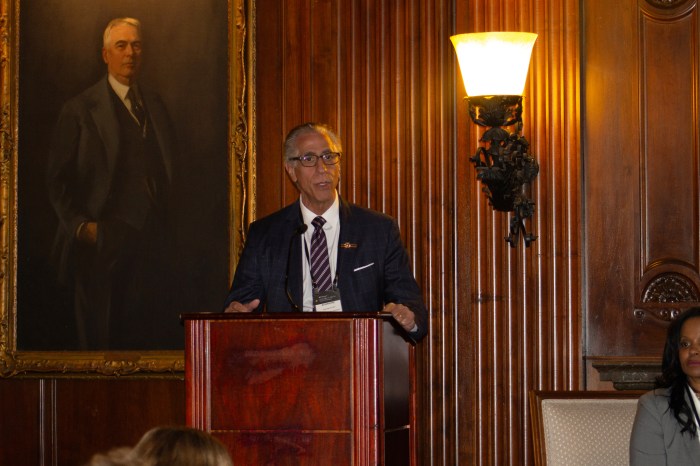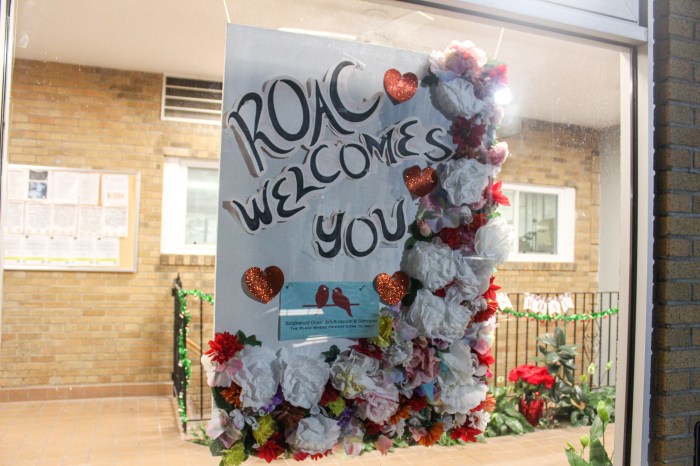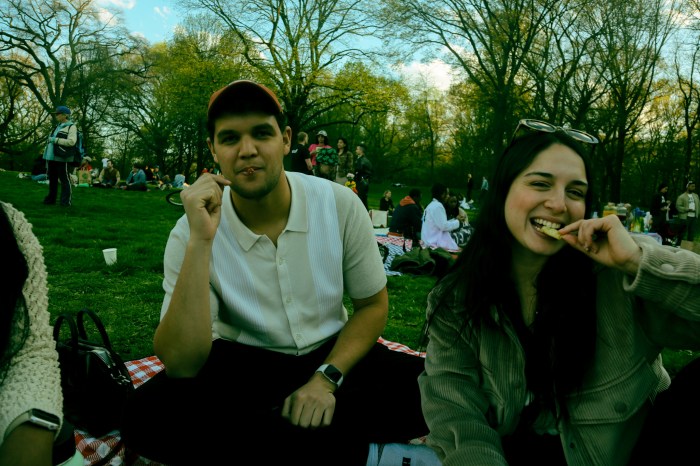LIGHTING IT UP: N.Y.U. Faculty Against the Sexton Plan fired their latest volley against the university’s 2031 mega-development scheme on Wednesday evening — but it was noiseless, since it was a light show. On behalf of N.Y.U. FASP, “The Illuminator Team,” who used a truck with a projector on top, spent a couple of hours beaming images around Washington Square — on Bobst Library, a building on Washington Square North and, finally, the arch. One of the pieces notably featured crime-scene tape and the slogan “Condemned by N.Y.U.” We hear that next week, N.Y.U. FASP will strike again, but this time harder, with paper — filing their lawsuit against the massive plan, which would add 2 million square feet of space to the university’s two South Village superblocks. The Greenwich Village Society for Historical Preservation is a co-plaintiff in the suit.
WADING INTO PIER 40 FLAP: The New York Times on Tuesday took on the Pier 40 issue in an editorial. The Gray Lady didn’t exactly come out in support of the controversial “R” word — residential — for the sprawling West Houston St. pier, but one could possibly read it between the lines, specifically, this one: “Park advocates and the deputy mayor for economic development, Robert Steel, believe the law should be broadened to include such possibilities as office space, a hotel or other developments.” Hmm, “other developments”… . What might those include? Anyway, what was clear was that the Times did make one goof in the editorial. Noting how the Hudson River Park Trust has been closing off “unsafe areas” of the crumbling pier, the Times claimed that the Trust has taken one of Pier 40’s three playing fields offline. Wondering if we’d missed something, we reached out to Trust spokesperson Lee Alman, who informed us, “None of the ball fields have been closed on Pier 40. It turns out the editorial was referring to what’s known locally as the ‘passive area’ — the unprogrammed area adjacent to the upstairs ball field. The passive area has been closed since the summer when the stairway was closed.” A day after the Times editorial, Assemblymember Deborah Glick blasted back in an e-mail blast. “Not surprisingly, The New York Times recently published an op-ed in support of more development at Pier 40,” Glick said. “For the uninitiated, The New York Times has long argued for inappropriate development at Pier 40. In fact in 2008 they came out in favor of a dreadful Related proposal that would have created a permanent home for Cirque du Soleil on the ball fields of Pier 40. … Once again The New York Times has demonstrated that they are out of step with the needs of residents on the West Side. … We will need an organized citizenry to overcome the power of developers who have an inside track with the city administration and the Hudson River Park Trust,” Glick stated, adding, “Residential development will put the ball fields at great risk and I will oppose efforts to change state law. Our fields would be used as a staging area while the luxury residential development is being constructed, and afterward the hours of playing time will no doubt be curtailed by the new residents of Pier 40 who will not be enthusiastic about the prospect of ball fields in operation late into the night or early in the morning on weekends. Anyone who tells you otherwise has not clearly thought the situation through or is a developer and is being disingenuous.”
KOCH BETTER, BUT ‘DISTRESSED’: After being treated for anemia earlier this month, Mayor Ed Koch is feeling much better. “I’m fully recovered,” he told us last week. He suffers from anemia, and had been feeling a bit weak lately, so a blood transfusion was prescribed. It made Hizzoner, 87, call off his plan to campaign for Obama in Florida and elsewhere, though he assured he remains an Obama supporter. Yet, he told us he’s “very distressed” with how the president has responded to the violence in Libya and Egypt. Among other things, Koch thinks the U.S. should cut off whatever remains of the $2 billion it gives Egypt annually, as well as what we give to Libya.
TRUE BELIEVER: Village activist Sharon Woolums reports that she saw Frances Goldin down at Zuccotti Park on Sunday evening, and the legendary, lavender-clad, Lower East Side radical was looking great. “She said, ‘This is the most beautiful Rosh Hashana I’ve ever been to,’” Woolums said. “When I asked her what she thought of the Occupy movement thus far, she said, ‘I think they’re going to save the planet.’”
$41 MIL FOR E.V. CHURCH? The Local: East Village, The New York Times-facilitated N.Y.U. news blog, last week reported some new information on the expected sale of Mary Help of Christians Church at E. 12th St. and Avenue A. According to The Local, court documents indicate that on Aug. 29, the Church of Mary Help of Christians and Trustees of St. Patrick’s Cathedral filed a petition to sell the East Village property, including the 100-year-old church and school buildings, the rectory and the parking lot that was home to a long-running flea market. A contract dated May 11 reportedly indicated the sellers had agreed to a total purchase price of $41 million. Evidence appears to point to Douglas Steiner, owner of Steiner Studios in the Brooklyn Navy Yard, as the prospective buyer. Steiner, based on an earlier statement he made about closing on a site for a development “south of 23rd St.,” could well be planning a 100-unit, luxury residential project at the Mary Help of Christians site. We asked Joseph Zwilling, the spokesperson for the Catholic Archdiocese, if he could confirm or deny the report, but he again told us he couldn’t say anything definite regarding a sale. “Status hasn’t changed,” he said.
TRUCKING IN FACTS: So how can Carl Rosenstein, a.k.a. The Angry Buddhist, be so sure the flatbed tractor-trailer that killed Soho’s Jessica Dworkin was illegal in the city, as in more than 55 feet long? “I spent many years fighting illegal trucking on Broome St. and Canal St. from the early 1990s into Alan Gerson’s first term in the City Council,” Rosenstein responded to our query. “I became completely versed in all of the trucking regulations in New York City, including the maximum length, 55 feet, and maximum weight, 80,000 pounds, as well as the difference between a Truck Route and a Local Truck Route. I met with Department of Transportation Commissioner Iris Weinshall (Chuck Schumer’s wife) and Manhattan Borough deputy commissioners and more than once with Chief Mike Scagnelli, head of N.Y.P.D. Manhattan Traffic. I worked closely with Councilmember Kathryn Freed and then-Councilmember Tom Duane. So over the course of this experience I developed an eye for all things trucking, just like a bird watcher who knows the difference between a wren and a swallow. Trailers basically come in industry standard increments, flatbed or box. They are either 43 feet, 48 feet or 53 feet. The cabs without the sleeper are about 10 feet in length. So it is feasible for a 53-foot-long tractor-trailer to legally enter the city. The cab that killed Jessica Dworkin, as pictured in the news, had a sleeper compartment. This is the dead giveaway that it is illegal. The sleepers add about another 10 feet. The flatbed that ran over Jessica was most likely 48 feet. This is the norm for flatbeds that carry steel and other construction materials. Even if it was 43 feet (unlikely), the sleeper cab would have pushed it to around 63 feet. Houston St. is part of the Thru Truck Route system in the city as is Canal St. and possibly Sixth Ave. So if a truck was avoiding the Verrazano Bridge toll (most likely in this case) the driver came over either the Williamsburg or Manhattan Bridge and was making his way across Manhattan, probably to the Lincoln Tunnel because the Holland Tunnel has been completely closed to tractor-trailers since 9/11.” Rosenstein suggested Dworkin’s family sue both the truck driver and his employer, since the driver is obligated to know the rules. A big part of the problem, Rosenstein added, is that police don’t seem to be out there ticketing overly long trucks anymore. “Trucking enforcement has disappeared,” he said. Rosenstein suspects this is due to pressure from the trucking industry.
STREET SMARTS: Hudson Square suddenly began looking a bit beachy/Stonehengy last week, as new planters, tan gravel and large, roughhewn stone blocks were installed near the Holland Tunnel entrances. A street lane on Varick St. between Broome and Watts Sts. has been “temporarily pedestrianized” and a triangular area in front of the tunnel entrance on Canal St. is now a “pedestrian refuge.” Ellen Baer, executive director of the Hudson Square Connection business improvement district, explained it’s all part of the BID’s raison d’être. “The idea is, first and foremost, to improve pedestrian safety,” she said. “And it should also, as a side benefit, help with the traffic channelization.” Basically, there are a ton of people crowding into Hudson Square nowadays — what with all the media and tech companies coming in — so pedestrian safety is needed. “The Hudson Square neighborhood now has 50,000 people walking around every day,” Baer noted. She added that new crosswalk stripings have been added to reflect the way people actually navigate the intersections. “You will actually be able to walk safely across the east side of Hudson St. at Canal St. now,” she assured. People are welcome to sit on the craggy blocks if they like, she said, but they’re mainly there to mark off the protected areas. The BID will be unveiling its full plan for streetscape improvements in the coming weeks.
CORRECTION: An article in last week’s issue on Trinity Real Estate’s proposed Hudson Square rezoning said that Hudson Square is currently 12 percent residential. In fact, the rezoning district is currently 4 percent residential. Trinity’s goal is, within 10 years, to boost that figure to 25 percent.


















